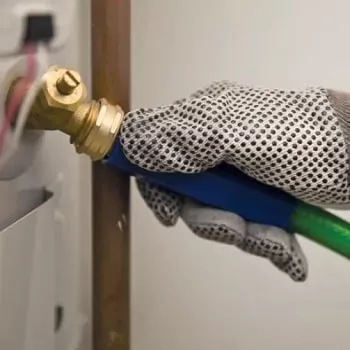
If you have an electric water heater, you will need to change the heating element from time to time. This is a job that a novice can tackle, as long as you take the time to read and learn how to replace a water heater element. Remember that no matter what kind of attention your system needs, we have great prices on all of our water heater parts. We carry reputable brands, like Bradford White. You'll be surprised to see how affordable elements are. Try this replacement BW 4500w, 240v water heater element set.
How to Change a Hot Water Heater Element
- Cut the power supply at the breaker - we recommend you do a voltage test to ensure there is no power running to the water heater.
- Attach a hose to the drain valve - you can use a garden hose. Connect it to the drain valve near the bottom of the tank. Run the hose outside the house or into a floor drain.
- Open the drain valve - we're only doing this now to test to make sure the drain is not clogged. Close it back up. Do not drain the water heater yet.
- Shut off the water supply - close the cold water supply valve.
- Open a hot water valve inside the home - run to the kitchen or a bathroom and turn on a faucet for hot water. You will not get hot water; it alleviates pressure in the line.
- Uncover the access panel - you'll need a screwdriver to remove the cover. There should be two panels, one for the upper element and another for the lower element. If there is insulation, remove it and set it aside for the moment.
- Uncover the thermostat - now, you should see the thermostat cover. Remove that, too.
- Examine the wiring - take a minute to look for damage. If any, it needs to be repaired.
- Disconnect the element wires - there should be two of them.
- Loosen the element - you will need a tool specific for the job, aptly named the heating element wrench. Once you've loosened the element, you no longer need the water weight in the tank.
- Open the drain valve - leave it open until the water stops coming out.
- Completely remove the element - please make sure you remove the gasket (or O-ring), too.
- Install the new element - start by attaching the fresh new gasket and pushing the element into position. Then, tighten the element with your special wrench. Last, reattach the two wires to the element.

Finishing Up
- Refill the water heater tank - close the drain valve and open the cold water supply valve. Watch for leaks as it fills. If you see any leaking from your new element, you'll probably need to reposition the gasket.
- Turn off the faucet that you left running - remember the faucet inside that you turned to hot? Once you see a steady stream of water coming out, go ahead and turn it off.
- Final tidying - replace the thermostat and access panel covers. Now everything should be back in its proper place.
- Turn the water heater on - only do this once the tank has completely filled (you can burn out a heating element if it isn't submerged).
Just be aware that when you turn the hot water on in the house, you'll probably hear air sputtering out of the line. This is normal, and the faucets just need to run a little bit to clear the line.
Are Water Heater Elements Universal?
No, there are a few key characteristics that will need your attention. You need the voltage and wattage to match (240v vs. 120v, for example). As general rules of thumb, you always need to keep the volts the same, but you can install an element with fewer watts, just not more. Check the label on your water heater for this information. Some tanks have different wattage for each element, so be aware of that. If you have a 20-140 gallon tank, you probably need 240v and 4500 watts.
There are two configuration types: screw-in and bolt-in. Bolt-in elements are hard to find these days, and if you have a tank configured for a bolt-in element, then you can use a screw-in adapter kit.
What Size Socket for a Water Heater Element
It takes a whopping 1-1/2" socket wrench to unscrew and screw in a water heater element, and it needs to be lengthy, too (5").
Replacing a Water Heater Element without Draining
It's a little risky (in terms of the odds of creating a mess) for the novice to try this approach. Also, it's good for the life of your water heater to drain it every other year or so, so why not take this opportunity to do that? But, if you want to give this clever solution a shot, check out this cool Christopher Moore tutorial video.
Thanks for Visiting PlumbersStock
If this article was helpful in learning how to replace a water heater element, please share it with your friends. Remember, we have great prices on water heater parts and accessories.
Related resources:
How to Replace a Thermocouple
How to Test a Water Heater Element
How to Clean a Thermocouple
How to Replace a Water Heater Thermostat
T&P Valve Keeps Opening
T&P Valve Replacement
How to Fix a Leaking Water Heater



